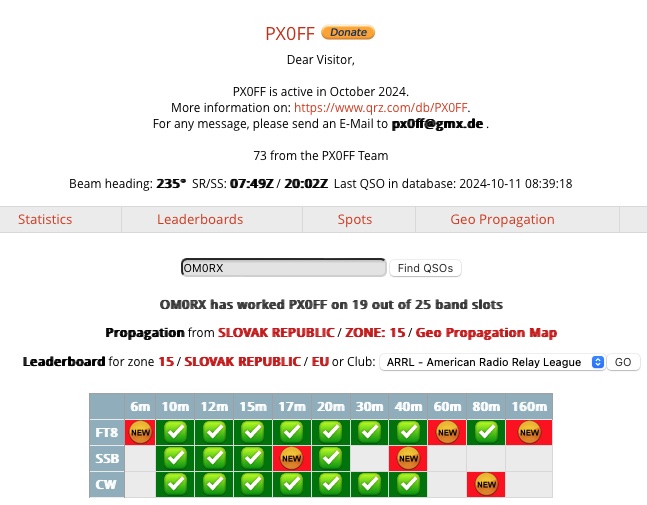Hunting a new DXCC – PX0FF

Hunting a new DXCC on HF in CW and SSB modes is akin to embarking on a grand adventure, much like a seasoned explorer setting sails for uncharted territories. For amateur radio enthusiasts, each new DXCC entity represents a unique destination, each with its own challenges and rewards. The journey of contacting these distant lands is not just about deploying powerful equipment or high-gain antennas; it’s a dance of strategy, patience, skill, and a sprinkle of luck.
Imagine a seasoned hunter, clad not in camouflage but in the waves of radio frequencies, with determination in their heart and Morse code echoing in their mind. The thrill of the hunt lies in the challenge itself—each successful contact, or QSO, is a trophy, a testament to one’s expertise and perseverance.
In the realm of HF (High Frequency), the CW (Continuous Wave) mode is often compared to the art of silent communication. It is the serene, yet intense, form of dialogue where dots and dashes carry the weight of voices across the ether. To converse in CW is like speaking a language of rhythm and melody; it requires a trained ear and a mind sharp enough to decode the symphony of signals. When you hear the distinct sound of a distant station, it’s akin to spotting a rare bird in the vast expanse of a dense forest. You tune your radio, adjust the frequency, and with bated breath, you send out your call sign, hoping for a connection amidst the cacophony of competing chirps.
SSB (Single Side Band) mode, on the other hand, is the vibrant counterpart, full of voices and personalities reaching out from every corner of the globe. It is the art of conversation, a more personable interaction where voices crackle and pop with the enthusiasm of those eager to share their stories. In SSB, it’s not just about making contact; it’s about connecting with the person on the other side, perhaps learning a little about their journey and the land they inhabit. It’s a reminder that while technology connects us, it is the human element that binds us.
For those hunting new DXCCs, like the recent pursuit of the PX0FF DXpedition, the experience is a kaleidoscope of emotions. With 19 band slots already in the log I already have, the adventure becomes a blend of easy wins and formidable challenges. Each contact tells a different story. Some QSOs are swift and seamless, a gentle breeze in the vast expanse of radio waves. Others, however, are battles against the odds, where persistence and strategy play a crucial role.
Take, for instance, the recent triumph of making contact with PX0FF on 20 meters in CW. The airwaves were alive with activity, a bustling marketplace of signals. There, amidst the chaos, emerged an opportunity. As the operator began transmitting, I positioned my antenna with precision, setting up a split frequency, exactly 2up, cognisant of the impending pileup. In that fleeting moment, I transmitted my call sign once, and like a fisherman with a sharp eye and perfect timing, I reeled in the prize.
Such moments exemplify the essence of DXCC hunting. They illustrate that success in this arena is not solely reliant on power or equipment but rather on being at the right place at the right time, seizing the moment with a blend of skill and serendipity. It’s a reminder that in the world of amateur radio, the journey is as rewarding as the destination itself.
In conclusion, hunting a new DXCC on HF in CW and SSB modes is a pursuit of passion and expertise, a testament to the enduring spirit of amateur radio enthusiasts. Each contact is a bridge to a far-off land, a connection woven through the invisible threads of the atmosphere. It’s a celebration of technology, human ingenuity, and the timeless allure of exploration. Whether you’re a seasoned operator or a curious newcomer, the thrill of the hunt beckons, inviting you to tune in, reach out, and discover the world one QSO at a time.
